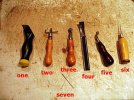- Joined
- Jun 13, 2007
- Messages
- 7,743
Right, so with that in mind, what brand of tools should I look at? I know that Tandy makes a higher end product than the stuff I'm used to (Craft tool or something like that), but is there another manufacturer that I should look to?
What about Springfield?
Also, anyone have any experience with the really cheap brands? Estone, Funkymall, etc? They sell these on Amazon and I think the ones I looked at got decent reviews.
What about Springfield?
Also, anyone have any experience with the really cheap brands? Estone, Funkymall, etc? They sell these on Amazon and I think the ones I looked at got decent reviews.
Last edited:



